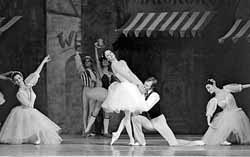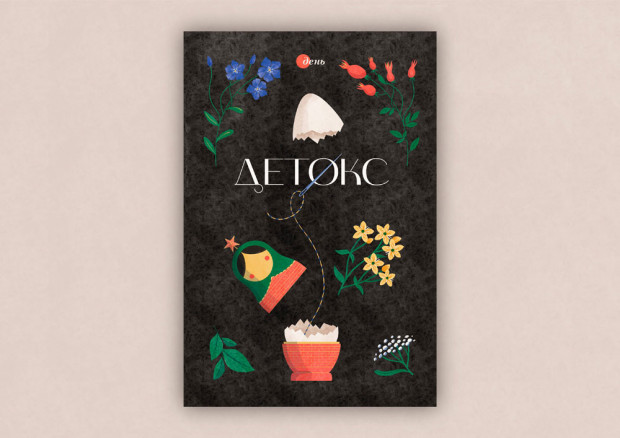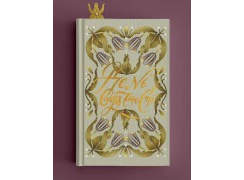Vienna Waltz With No Waltz

The National Opera hosted the premiere of Vienna Waltz, the first large-scale project by Aniko Rekhviashvili, head of the chair in modern choreography at the National University of Culture and Art. Aniko also wrote the libretto: a romantic story about how music is born. The main hero, composer Franz (Yevhen Kaihorodov), is in love with an ordinary girl by the name of Annelle (Yana Hladkyh), but then he sees the famous ballerina Carla (Tetiana Biletska) and is immediately infatuated. The plot centers around this love triangle. The score incorporates music by the great Austrian composer family of Johann Strauss and sons.
According to the producer, the ballet was born the hard way. Bringing the project to fruition took almost a year and a half. Anatoly Ikonnykov, production designer, had to redo the stage props three times, there was a great deal of argument about the wardrobe. On one thing everybody agreed: no copying the one used in the 1960s-1970s production of the Blue Danube by Yelena Tanhiyeva- Birzniyek, starring Valentyna Kalynovska (currently in charge of the ballet troupe at the National Opera). Together with the conductor Oleksiy Baklan Aniko selected Strauss scores and built the dramatic concept. Apart from the sparkling classical Geschichten aus dem Wienerwald (Tales from the Vienna Woods), Bayadere Waltz, the Blue Danube, and Voices of Spring by the Johann Strauss the Elder and Younger, they incorporated several pieces by Josef Strauss to expand the music range. Viktor Yaremenko, artistic director and stage project coordinator, was sure that by doing so they would present modern choreography on stage. Actually, that was why they invited Aniko Rekhviashvili, knowing her as an interesting and unconventional choreographer. Before that she had staged several concert numbers for prima Anna Kushnereva’s soiree.
The result was beautiful music and a colorful setting, but the whole performance unjustifiably drawn-out (three hours), with Act I especially monotonous; the plot seemed at a standstill despite a multitude of dances. Carla’s appearance in a limousine was spectacular, but that was all. Half of the act the prima humbly sat aside, and the costumes of the corps de ballet made a strange impression, playing with brighter colors than those of the main characters. At the same time, Annelle’s costume shone with precious stones (she was supposed to be an ordinary girl, after all). Worst of all, the language of choreography showed a poor vocabulary and the main characters lacked energy. Yevhen Kaihorodov is a dancer with good technique, yet he was Franz, an impassioned creative figure, the Waltz King, but it took quite some effort to picture him as Annelle’s Prince Charming. And the girl, supposedly the man’s muse, also turned out to lack expressiveness.
Act II made up for the first one’s shortcomings, with Tetiana Biletska her usual brilliant self and a scene from The Fledermaus. The prima and Vadym Burtan (Count Keiserling) made good duets in the boudoir and ballroom scenes, with Vadym displaying his masterful light sweeping leaps. His character was a true aristocrat with boiling passions behind the cool restrained front. Yet the finale proved unnecessarily hurried, the balloon scene serving as just another beautiful detail, nothing more.
Strangely, waltz tunes were constantly present, yet no one danced a single one. Aniko used them as a dramatic background. “I think that dancing a waltz is mauvais ton,” she explained to me. “We are so used to standards and we treat Strauss music superficially, as something light and beautiful, without any sophistication. Yet every such composition secrets the author’s emotions that have to be perceived. Waltz is a primitive music form accessible to all. To me, Strauss music is not just a triple meter ballroom dance, but an emotional condition. So form was not important. Content was. We do dance pas de gras, mazurka, French quadrille, or other nineteenth century parlor dances. Indeed, they served as the basis for the language of choreography at the time. It is important for me to convey modern music perception, so I fought over costumes, we discarded fans, bonnets, long plush dresses, the attributes of that epoch. With all the seeming lightness of this production it is technically very complicated. The cast had to sweat out their parts, so the costumes were made light and comfortable.”
Aniko said she had tried to make her production different from others on the National Opera’s repertory. She want her ballet to turn out “light, alive, not artificially aggressive, with blood, sweat, and tears.” At the dress rehearsal Aniko did not conceal a degree of disappointment. The cast and the orchestra did not put all their hearts into the job, saving energy for the premiere, except that the premiere was not much better. Perhaps they were all too tired or just failed to get that igniting spark? Vienna Waltz left one with a dual impression. It was good that the National Opera had decided to expand its traditional range and experiment. Progress requires fresh ideas and nonstandard approaches. Too bad the ballet did not turn out solid but a collections of scenes with a varying degree of success.






